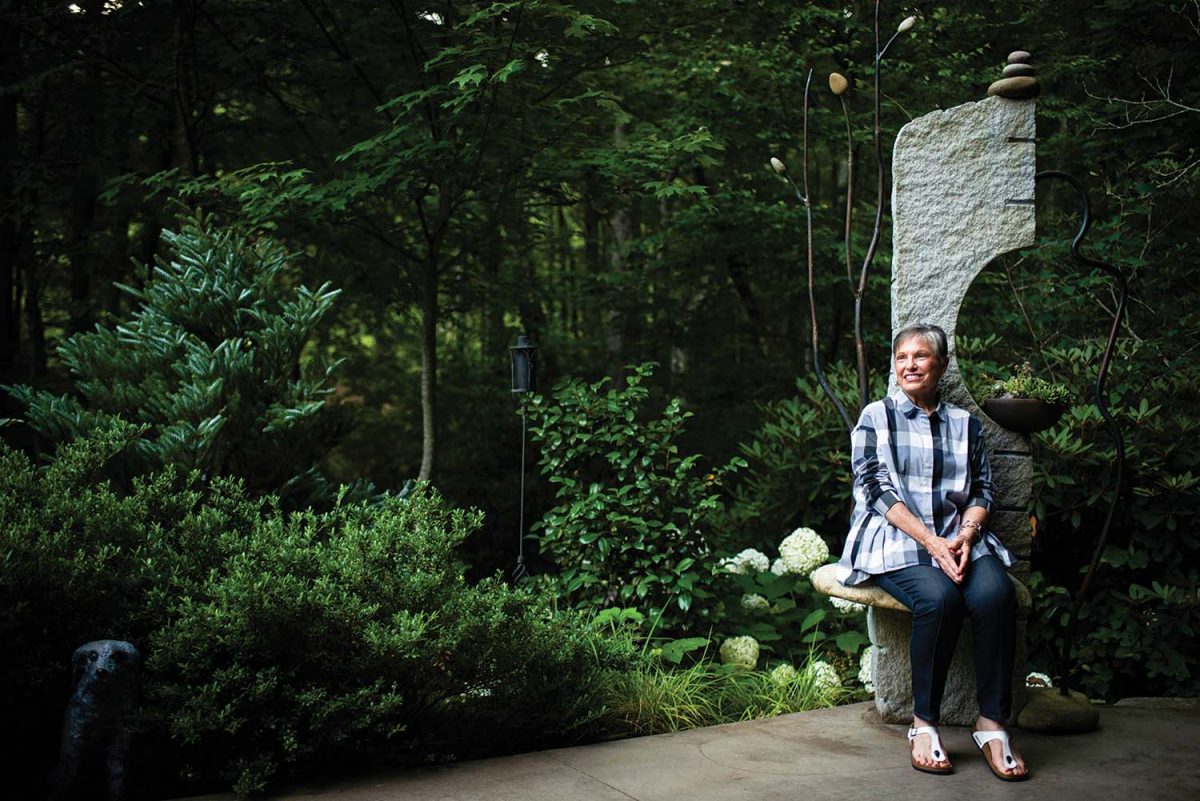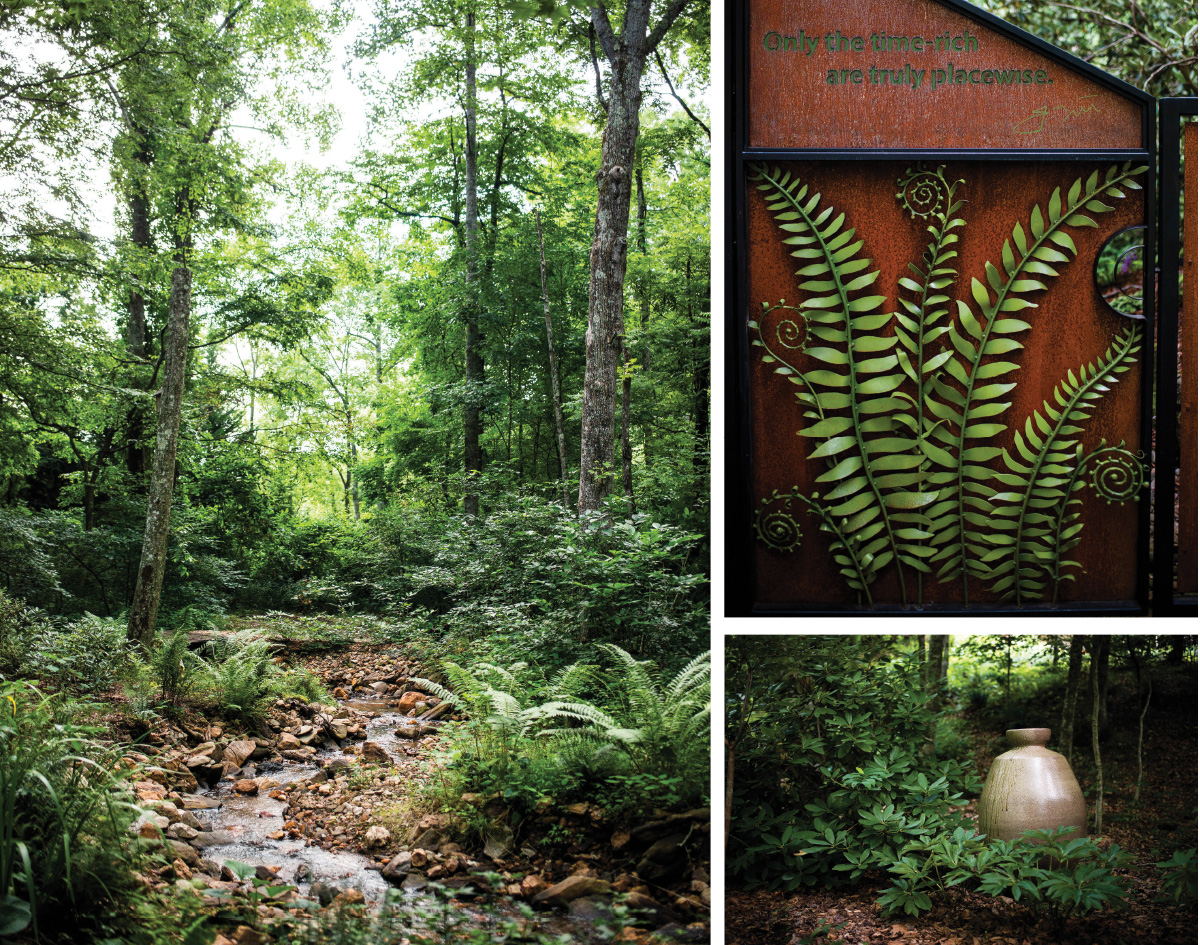
Mignon Durham in the biodiverse wonderland she calls “Devotion.” Photo by Karin Strickland
Ask any biologist with the North Carolina Wildlife Resources Commission: The Eastern Cougar, or felis concolor, was hunted to extinction long ago. Though these felines once roamed our untamed mountains under the cloak of night, they simply are not around today.
But Mignon Durham has a different theory. She believes that if you cultivate just the right habitat, mountain lions will come out of the woodwork. So far, she says, her hypothesis has proven to be true.
Durham’s nearly three-acre property on Robinson Creek Road in Asheville has been certified a Native Plant Habitat by the North Carolina Native Plant Society, a certified Wildlife Habitat by the National Wildlife Federation, and a certified Pollinator Habitat by Asheville GreenWorks. The place is home to more than 500 identified plant species, a host of insects and birds, and wild visitors of the four-legged variety (bears, deer, and bobcats). On a crisp morning this past summer, Durham says she also spotted a mother cougar and three cubs padding down her driveway. “Her tail was the dead giveaway,” she says. “It was a religious experience.”
For Durham, the tawny-colored cat validated her eight-year effort to transform a neglected, overgrown plot into a thriving ecosystem she calls “Devotion.” The gardener details the metamorphosis in her book, Devotion: Diary of an Appalachian Garden. Releasing in mid-October, the text is part memoir, part how-to guide, offering readers a deep dive into both the author’s garden and the author’s psyche. Here, Durham reveals more about her past and provides tips on how novice gardeners can create a habitat capable of reviving the extinct.
Where did your love for gardening begin?
I grew up in Winston-Salem in the 1950s and 1960s, when it was safe for a kid to ride their bicycle to school or to the swimming pool. I spent a lot of time outside. I would go visit Reynolds Gardens and Tanglewood, the manor home of William Neal Reynolds, brother to [tobacco executive] R.J. Reynolds. Those places inspired me. But I didn’t start gardening until I left my technology career in the mid-1990s and finally had the time to develop this passion at Brookfield, my home in Lewisville [North Carolina, near Winston-Salem].

You obviously know a thing or two about attracting wildlife. What native plants are good for attracting bees, birds, and other pollinators?
The chokeberry produces this beautiful flower in the spring that turns into a berry that remains on the shrub until winter. This past winter, as I was in my office writing, I looked out my window and saw a flock of probably 50 Cedar Waxwings land and devour every single berry. I had never seen a Cedar Waxwing before. I’ll never forget their vibrant colors.
I also have mayapples here on the property. This spring, I noticed a whole new patch fairly far away from the original patch. I thought, “How does that happen?” I did some research and found that mayapples have a little bud that box turtles eat. So the turtles eat the bud, walk off into the woods, and expel the seeds. Then, you have a new, magical patch. It’s been fascinating to learn about all the diversity that is necessary for wildlife.
Speaking of diversity, you have more than 500 species of plants on your property. How do you keep up with them all?
My garden designer and her husband designed a software package that allows me to enter data on every plant I buy and every plant I find in the woods. Most garden plants have tags with QR codes that you can scan with your phone to access my database. The database tells you where I got it, when I planted it, problems with the plant, and what it looks like in different seasons. I’m a computer person, so that’s the way my mind works.

Wow. How should a beginner gardener—someone without a database—go about selecting plants?
First, you need to be aware of the conditions where you want to put the plant. Is it sunny? Is it shady? Is it wet? Is it dry? That will help you figure out what palette of plants you should be choosing from. Keep in mind that most plants don’t like soggy feet. Good drainage is a must, and drainage should be included in the original design process.
Some people just want a pretty garden. Other people want to restore natural habitat. Do you have any suggestions for the latter?
If you have a tangled mess of a property, take the time to remove the invasive species like Oriental Bittersweet, poison ivy, and Multiflora Rose, and then give it a season to see what pops up. When I started restoring my woodland garden, I had maybe 75 to 100 different species that only appeared when I started removing all of the invasives. Now, I also have red-shouldered hawks, screech owls, and monarch butterflies. Sure, my three acres won’t save the world — but it’s so much more than a pretty place.
Devotion: Diary of an Appalachian Garden will be available for purchase ($40) in mid-October. To buy the book, visit mignondurham.com. For a personalized copy, e-mail the author at mignondurham@gmail.com.
